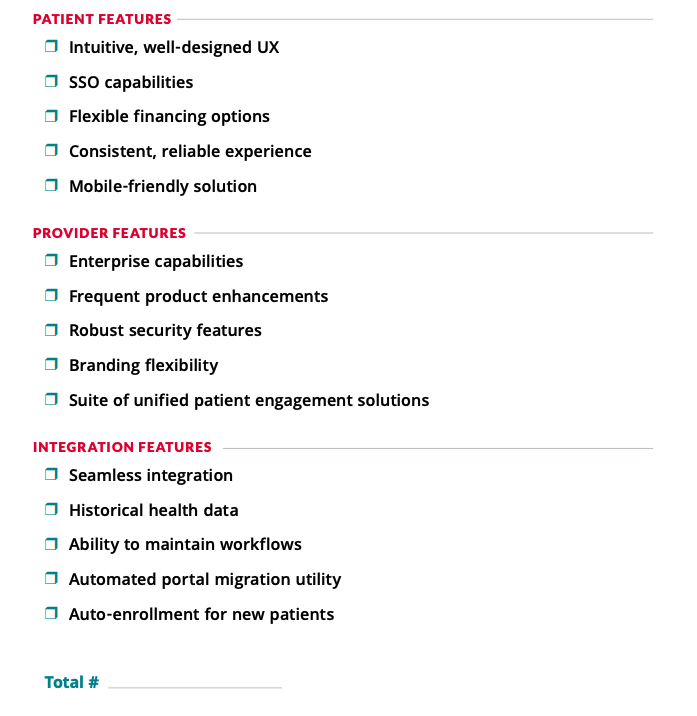Chapter 1
15 Key Features to Look for in a Patient Portal
When vetting different patient portal companies, it’s important to keep the patient, practice, and provider needs in mind. Additionally, certain integration features are essential for realizing the benefits of a well-designed, feature-rich patient portal. In this section, let’s take a look at the key features to look for, broken down by which group they benefit most.
Patient Features
Feature 1: Intuitive, Well-Designed UX
An intuitive, well-designed user experience (UX) is what separates the most lacking patient portals from the best. Patient portals with a poor UX often have low adoption and can make it difficult to boost engagement, which can ultimately lead to increased patient churn, an influx of negative online reviews, and decreased profitability for your practice.
Evaluate your patient portal’s UX by asking these questions:
- Is it difficult to navigate?
- Does it have a clunky, outdated user interface (UI)?
- Do your patients struggle with registration and login issues?
- Does it house complex medical content that’s hard for patients to comprehend?
If the answer to any of these questions is yes, consider upgrading the look and feel of your patient portal to offer a clean, intuitive, user-friendly experience that meets the expectations of today’s tech-savvy consumers.
Feature 2: SSO Capabilities
Single sign-on (SSO) is a standard feature of many systems today, offering users a quick and convenient login experience. When an integrated solution lacks SSO capabilities, users are often required to enter their login details multiple times to access different related tools and features.
A cumbersome login process without SSO can easily result in poor portal adoption, because patients may become frustrated with a less-than-stellar digital experience that doesn’t align with their expectations. On the other hand, you can simplify the registration and login processes—and ultimately boost portal adoption and engagement—by offering SSO capabilities.
Feature 3: Flexible Financing Options
Amid today’s rising healthcare costs and high insurance premiums, many patients struggle to afford the care they need. To address these challenges, many of today’s healthcare patients look to their providers for digital payments and more flexible financial options.
In fact, according to a recent survey, 63 percent of patients want their healthcare providers to offer flexible, online payment plans—much like the online retailers consumers are so familiar with. Additionally, 54 percent of patients said they would prefer to be kept up to date via digital reminders regarding financial obligations.
Feature 4: Consistent, Reliable Experience
Patients want a reliable digital experience that’s consistent each and every time they log into your portal. A patient portal with a consistent user experience offers patients a unified way to manage their care journey, from pre-appointment to the in-office visit, to post-visit follow-up, ongoing treatment adherence, and engagement between appointments.
Feature 5: Mobile-Friendly Solution
Modern consumers are accustomed to having regular access to mobile-friendly tools that are available at any time, from any place, and via a method that’s convenient for them. To align with consumer expectations and offer an exceptional patient experience, your portal should either be accessible via a native mobile application or optimized for mobile browsers.

Provider Features
Like patients, specific portal features are particularly beneficial for healthcare organizations and providers. They can improve care quality, streamline operations, and even improve profitability and support the practice as it grows. Those include:
Feature 6: Enterprise Capabilities
As your practice grows, so does the need to invest in a patient portal with enterprise capabilities. Patient portals should be designed for scale and enterprise-wide usage. These elements enable practice managers and providers to manage the entire care team using one highly effective, integrated solution.
Feature 7: Frequent Product Enhancements
Your practice’s patient portal should be as ever-evolving as the healthcare industry overall. That’s why frequent platform updates and enhancements play an essential role in ensuring your portal offers a top-quality digital experience that checks off every box and continuously improves over time.
Feature 8: Robust Security Features
With the risk of data breaches and cybersecurity threats higher than ever before, healthcare practices need to take proper precautions to protect confidential data and prevent attacks on their servers—particularly when said data is stored on the cloud. That means putting robust security protocols in place to ensure your portal is safe, with added protection from threats.
Feature 9: Branding Flexibility
Your portal serves as your digital front door, so it goes without saying that you want it to look and feel like your brand. That’s why branding flexibility is an important feature to look for in a patient portal solution. With the ability to customize your portal to align with the standards you’ve established for your brand, you can create a digital healthcare hub that’s familiar to patients and mirrors your office operations.
Feature 10: Unified Patient Engagement Solutions
Many of the electronic health records (EHRs) on the market today offer a patient portal and some level of engagement features. However, these tools often aren’t as comprehensive as dedicated patient engagement solutions.
To fill this void, some portal providers will offer separate engagement solutions that have been added to the system via an acquisition. In most cases, these add-ons are not native to the patient portal, which creates a disjointed experience for patients and workflow headaches for providers.
The best portal providers will offer a suite of engagement tools that are integrated into your patient portal using a common infrastructure, enabling each product to communicate effortlessly between applications.
These engagement solutions should include:

Integration Features
Perhaps the biggest hurdle practices face when changing patient portals are the challenges associated with the actual migration. The inability to create a seamless transition from one portal to the next can create headaches for providers and a poor experience for patients.
With that said, the best patient portal vendors will make this process as easy and painless as possible. Some key features to look for include:
Feature 11: Seamless Integration
Seamless application programming interface (API) integration with your EHR and other existing solutions is essential for operating efficiently and taking full advantage of your tech stack. By seamlessly integrating with the rest of your technology, you can ensure your systems are talking to each other and working in tandem—not to mention create an experience that’s familiar for your patients and functional for your practice.
Feature 12: Historical Health Data
Another critical feature in a patient portal is the availability of historical health data through EHR integration. Providers utilize patient data regularly to deliver comprehensive and effective care that takes every relevant detail into consideration.
Personal health data should include existing information on the following:
- Appointments
- Medications
- Lab results
- Known allergies
- Any documentation on the patient’s prior care experiences
Feature 13: Ability to Maintain Workflows
Your technology needs to work for you—not against you. Rather than completely reinventing the wheel, you can use your portal solution to deliver top-quality care efficiently and effectively. That’s why your patient portal should maintain (and enhance) your existing practice workflows by offering capabilities like inbox message routing, so you can keep doing what you do best without running into unnecessary operational obstacles along the way.
Feature 14: Automated Portal Migration Utility
When you switch from one platform to another, you want to avoid as much time-consuming manual work as possible to minimize your practice’s administrative burden. However, some vendors do not offer a portal migration utility to easily move registered patients over to their system, which creates a significant amount of manual work and requires patients to re-verify their identity to access protected health information (PHI).
Feature 15: Auto-Enrollment for New Patients
When you attract new patients to your practice, of course you want them to start taking full advantage of your portal. Auto-enrollment for new patients makes this easy by automating the process and providing instant access—after identity verification and authentication, of course. Security first!

.png?width=653&name=How%20Effective%20is%20My%20Patient%20Portal%20Checklist(1).png)




